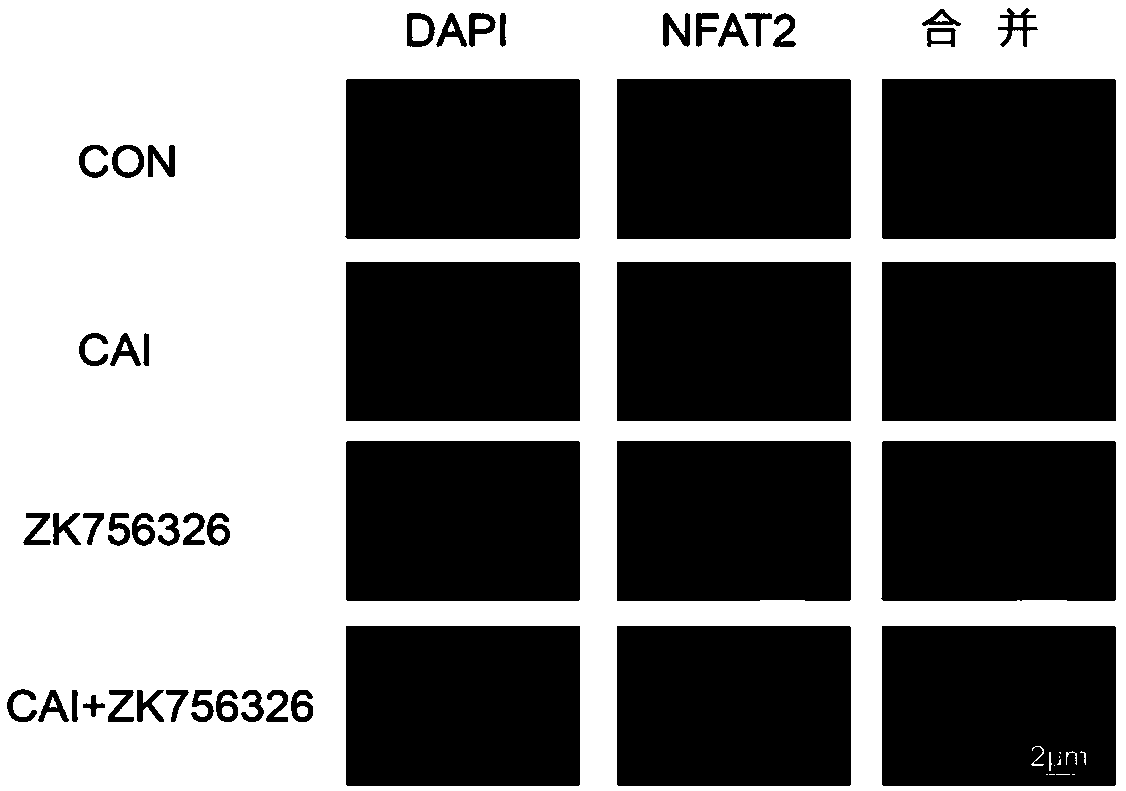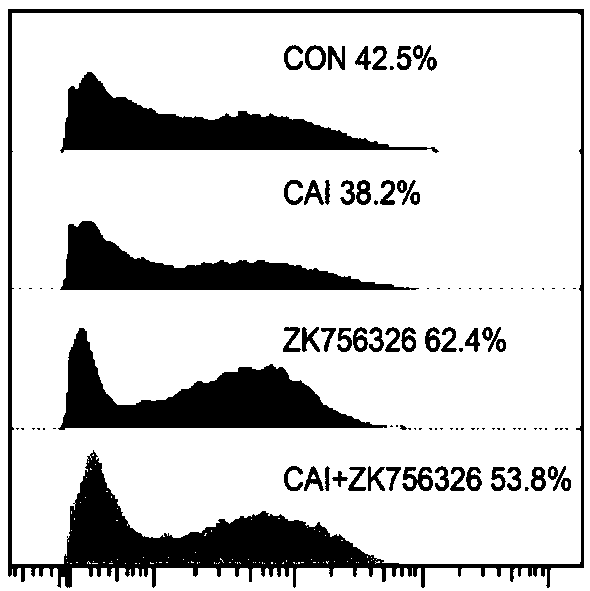Application of CAI (Carboxyamidotriazole) and IDO1 (Indoleamine 2,3-Dioxygenase) inhibitor combination in resisting tumor
A technology of IDO1 and carboxyamine triazole, applied in the medical and pharmaceutical fields, can solve the problems of cytokine release syndrome and adverse reactions that cannot be ignored, and achieve the effects of promoting lymphocyte infiltration, no toxic side effects, and reducing expression.
- Summary
- Abstract
- Description
- Claims
- Application Information
AI Technical Summary
Problems solved by technology
Method used
Image
Examples
Embodiment 1
[0055] Example 1: Carboxyamidotriazole inhibits the nuclear factor NFAT2 of activated T cells from entering into the nucleus.
[0056] 1. Experimental method
[0057] CD8+ T cells were isolated from mouse splenocytes by negative sorting and activated with anti-CD3 / CD 28 microspheres for 48 hours. Then the cells were divided into CON (DMSO solvent) group, CAI (10 μM) group, ZK 756326 (1.8 μM) group, and CAI and ZK756326 group, and the cells were treated. After 24 hours, cells were fixed in 3D Matrigel, fixed, dehydrated, embedded, sectioned, and subjected to immunofluorescent staining, DAPI (blue), NFAT2 (green).
[0058] 2. Experimental results
[0059] For the results of confocal immunofluorescence images see figure 1 , where the merged image of the highlighted area shows that the localization of NFAT2 in cells differs among the groups. After CAI treatment, it can inhibit the nuclear translocation of NFAT2. ZK756326 stimulates the nuclear import of NFAT2 and reduces the ...
Embodiment 2
[0060] Example 2: Carboxytriazole reduces the percentage of PD-1+CD8+T cells
[0061] 1. Experimental method
[0062] CD8+ T cells were isolated from mouse splenocytes by negative sorting and activated with anti-CD3 / CD 28 microspheres for 48 hours. Then the cells were divided into CON (DMSO solvent) group, CAI (10 μM) group, ZK 756326 (1.8 μM) group, and CAI and ZK756326 group, and the cells were treated. After 24 hours, flow cytometry was used to evaluate the effect of CAI on the percentage of PD-1+CD8+T cells in the activated CTLs of the mouse spleen.
[0063] 2. Experimental results
[0064] PD-1+CD8+ T cell subsets were reduced by 8% to 15% after CAI treatment. However, after ZK756326 treatment, there are more PD-1 expressing cells in primary T cells, and the stimulation antagonizes the effect of CAI, see Figure 2A and 2B .
Embodiment 3
[0065] Example 3. Detection of the effects of CAI combined with AhR / IDO1 inhibitors on the apoptosis of solid tumor cells in the co-culture system of CD8+ T cells and tumor cells
[0066] 1. Experimental method
[0067] CD8+ T cells were isolated from mouse splenocytes by negative sorting, or CD8+ T cells were isolated from PBMCs of volunteers. After activation by CD3 / CD 28 microspheres for 48 hours, they were mixed with mouse melanoma cells B16 or human Co-culture of colorectal cancer cells HCT116. Ratio 20:1, co-culture for 24 hours and administer drugs: CAI (10 μM), DMF (20 mM), 1-MT (0.2 mM). Flow cytometry was used to detect tumor cell apoptosis.
[0068] 2. Experimental results
[0069] Both DMF and 1-MT have some weak anti-tumor effect when administered alone, but the effect is not as good as that of CAI. However, when CAI is administered in combination with DMF or 1-MT, the antitumor activity in the co-culture system is significantly better than that of CAI adminis...
PUM
 Login to View More
Login to View More Abstract
Description
Claims
Application Information
 Login to View More
Login to View More - R&D
- Intellectual Property
- Life Sciences
- Materials
- Tech Scout
- Unparalleled Data Quality
- Higher Quality Content
- 60% Fewer Hallucinations
Browse by: Latest US Patents, China's latest patents, Technical Efficacy Thesaurus, Application Domain, Technology Topic, Popular Technical Reports.
© 2025 PatSnap. All rights reserved.Legal|Privacy policy|Modern Slavery Act Transparency Statement|Sitemap|About US| Contact US: help@patsnap.com



